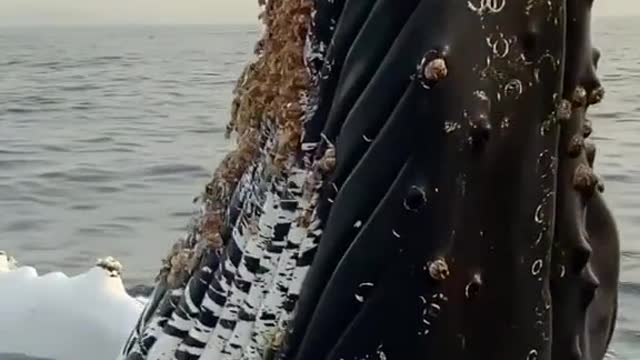Premium Only Content

A whale decided to come up to me.
The story of the huge and fragile whale whale—the legendary story of the life-and-death struggle between man and beast—is part of the past. However, there are still people hunting these elegant behemoths today.Click to watch the clip
Click to watch the clip
Before electricity became a daily energy source, houses were illuminated by whale oil. In order to obtain blubber and whale meat, many species of whales were hunted and killed on a large scale. During the most prosperous period of the world's whaling industry, one species of whale species was hunted to extinction. During the entire 100 years of the 20th century, whale products can be seen everywhere, including cosmetics for women and motor oil for machines. In one whaling season in 1961 alone, 66,000 whales were killed.
In 1986, a temporary ban was imposed on commercial whaling activities. The purpose was to save the whales that were about to go extinct and to make up for the number of whales that were reduced due to the large-scale hunting. In order to curb the momentum of commercial whaling, the Indian Ocean was declared a whale-free zone. However, these conservation measures seem to be ineffective. As new threats have exacerbated the whale’s tragic situation, 7 of the 13 existing whale species are still endangered.
Because the catch limit is often set too high, the whales cannot reproduce quickly. In Japan and Norway, whalers make a fortune by selling whale meat, where it can sell for $350 per kilogram of whale meat. The number of whale kills is often falsely reported, and some people have even conducted commercial whaling activities under the guise of "scientific research."
The North Atlantic right whale has been hunted to the point of being almost extinct. Right whales move slowly-unlike most whales that sink quickly after death, this whale floats on the ocean surface after death-making it the easiest type of whale to kill, and its name comes from . Although right whales have been protected for 50 years, the number of North Atlantic right whales has not increased significantly in the past 15 years. In addition to natural causes of death, nearly 90% of right whales die from violent collisions with passing ships.
Although in the past commercial whaling was the sole cause of the extinction of many whale species, the threats facing whales now come from other sources: entanglement in fishing lines, pollution from toxic substances, collisions with ships, gas and oil in the whale foraging area Engineering, climate change and habitat degradation, etc.
Marine environmental pollution has many effects on whales. Chemical substances floating on the ocean surface are absorbed by fin whales and accumulate in their body oils. These toxins then slowly enter their milk and eventually make the baby whale sick.
In order to protect the planet we live on and the animals on this earth, a global initiative is currently being carried out. The United Nations Environment Programme has implemented the world’s largest biological conservation agreement-the Convention on International Trade in Endangered Species of Wild Fauna and Flora (referred to as the Convention on Endangered Species). This intergovernmental international convention aims to ensure that the international trade of wild animals and plants does not threaten the survival of wild animals and plants.
So far, the governments of 160 countries have passed the CITES. The convention provides varying degrees of protection for 35,000 plant and animal species. Since the Convention entered into force in 1975, there has not been an extinction of a species protected by the CITES.
-
 LIVE
LIVE
The Quartering
1 hour agoDaily Wire CIVIL WAR Over Karmelo Anthony, GTA 6 Trailer Drops, Lady Gaga TERROR Attack & More
22,436 watching -
 1:38:28
1:38:28
Russell Brand
2 hours agoHOLY SH*T… Trump ENDS Gain Of Function, Tulsi CONFIRMS Ukraine Bio-Labs! – SF578
121K36 -
 21:03
21:03
UnchartedX
12 days agoAre the Precision Ancient Stone Vases Modern Fakes? Provenance, and Scanning in the Petrie Museum!
5.07K8 -
 LIVE
LIVE
Barry Cunningham
2 hours agoTRUMP DAILY BRIEFING: CANADA COMES TO KISS THE RING! WESLEY HUNT INTERVIEW!
1,418 watching -
 LIVE
LIVE
Right Side Broadcasting Network
4 hours agoLIVE: Pam Bondi Holds a DOJ Presser, Trump Holds FIFA Task Force Meeting, and More - 5/6/25
2,783 watching -
 LIVE
LIVE
StoneMountain64
1 hour agoWildest Warzone CUSTOM Games
362 watching -
 58:13
58:13
Sean Unpaved
1 hour agoHoops Shocks, Nature's Wrath, & Number Crunch
18.2K -

Simply Bitcoin
3 hours ago $2.24 earnedCoinbase $400B BITCOIN BACKFLIP CONFIRMS 2025 Is Different! | EP 1238
33.6K1 -
 50:33
50:33
Ben Shapiro
2 hours agoEp. 2193 - The Ongoing INSANITY of The Met Gala
27.9K9 -
 25:46
25:46
CryptoWendyO
1 hour ago $0.23 earnedKevin O’Leary "Strategic Bitcoin Reserve will never happen.” BUT IT DID!
6.82K